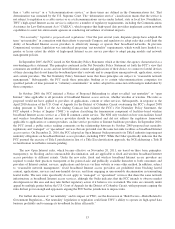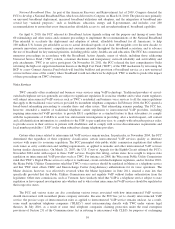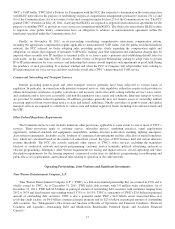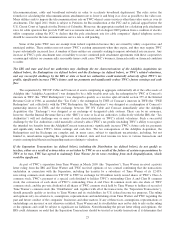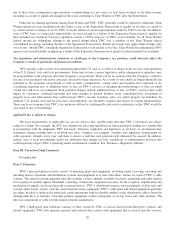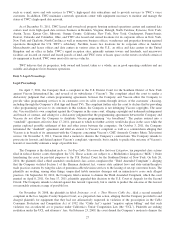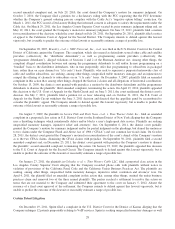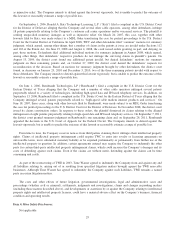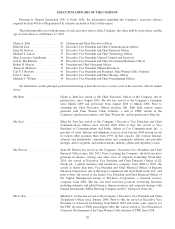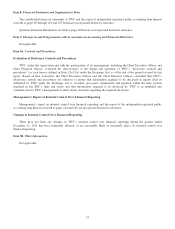Time Warner Cable 2011 Annual Report Download - page 33
Download and view the complete annual report
Please find page 33 of the 2011 Time Warner Cable annual report below. You can navigate through the pages in the report by either clicking on the pages listed below, or by using the keyword search tool below to find specific information within the annual report.telecommunications, cable and broadband networks in order to accelerate broadband deployment. The rules revise the
formula for calculating the telecommunications attachment rate to lower it and bring it as close as possible to the video rate.
Many utilities seek to impose the telecommunications rate on TWC when it carries services other than video services over its
attachments. The April 2011 Order is subject to Petitions for Reconsideration at the FCC and to judicial appeal before the
U.S. Circuit Court of Appeals for the District of Columbia. Moreover, the appropriate method for calculating pole attachment
rates for cable operators that provide VoIP services remains unclear, and an August 2009 petition from a coalition of electric
utility companies asking the FCC to declare that the pole attachment rate for cable companies’ digital telephone service
should be assessed at the telecommunications service rate is still pending.
Some of the poles TWC uses are exempt from federal regulation because they are owned by utility cooperatives and
municipal entities. These entities may not renew TWC’s existing agreements when they expire, and they may require TWC
to pay substantially increased fees. A number of these entities are currently seeking to impose substantial rate increases. Any
increase in TWC’s pole attachment rates or inability to secure continued pole attachment agreements with these cooperatives
or municipal utilities on commercially reasonable terms could cause TWC’s business, financial results or financial condition
to suffer.
The IRS and state and local tax authorities may challenge the tax characterizations of the Adelphia Acquisition (as
defined below), the Redemptions (as defined below) and the Exchange (as defined below), or TWC’s related valuations,
and any successful challenge by the IRS or state or local tax authorities could materially adversely affect TWC’s tax
profile, significantly increase TWC’s future cash tax payments and significantly reduce TWC’s future earnings and cash
flow.
The acquisition by TW NY Cable and Comcast of assets comprising in aggregate substantially all of the cable assets of
Adelphia (the “Adelphia Acquisition”) was designed to be a fully taxable asset sale, the redemption by TWC of Comcast’s
interests in TWC (the “TWC Redemption”) was designed to qualify as a tax-free split-off under section 355 of the Internal
Revenue Code of 1986, as amended (the “Tax Code”), the redemption by TWE of Comcast’s interests in TWE (the “TWE
Redemption” and collectively with the TWC Redemption, the “Redemptions”) was designed as a redemption of Comcast’s
partnership interest in TWE, and the exchange between TW NY Cable and Comcast immediately after the Adelphia
Acquisition (the “Exchange”) was designed as an exchange of designated cable systems. There can be no assurance,
however, that the Internal Revenue Service (the “IRS”) or state or local tax authorities (collectively with the IRS, the “Tax
Authorities”) will not challenge one or more of such characterizations or TWC’s related valuations. Such a successful
challenge by the Tax Authorities could materially adversely affect TWC’s tax profile (including TWC’s ability to recognize
the intended tax benefits from the Adelphia/Comcast transactions), significantly increase TWC’s future cash tax payments
and significantly reduce TWC’s future earnings and cash flow. The tax consequences of the Adelphia Acquisition, the
Redemptions and the Exchange are complex and, in many cases, subject to significant uncertainties, including, but not
limited to, uncertainties regarding the application of federal, state and local income tax laws to various transactions and
events contemplated therein and regarding matters relating to valuation.
If the Separation Transactions (as defined below), including the Distribution (as defined below), do not qualify as
tax-free, either as a result of actions taken or not taken by TWC or as a result of the failure of certain representations by
TWC to be true, TWC has agreed to indemnify Time Warner for its taxes resulting from such disqualification, which
would be significant.
As part of TWC’s separation from Time Warner in March 2009 (the “Separation”), Time Warner received a private
letter ruling from the IRS and Time Warner and TWC received opinions of tax counsel confirming that the transactions
undertaken in connection with the Separation, including the transfer by a subsidiary of Time Warner of its 12.43%
non-voting common stock interest in TW NY to TWC in exchange for 80 million newly issued shares of TWC’s Class A
common stock, TWC’s payment of a special cash dividend to holders TWC’s outstanding Class A and Class B common
stock, the conversion of each share of TWC’s outstanding Class A and Class B common stock into one share of TWC
common stock, and the pro-rata dividend of all shares of TWC common stock held by Time Warner to holders of record of
Time Warner’s common stock (the “Distribution” and, together with all of the transactions, the “Separation Transactions”),
should generally qualify as tax-free to Time Warner and its stockholders for U.S. federal income tax purposes. The ruling
and opinions rely on certain facts, assumptions, representations and undertakings from Time Warner and TWC regarding the
past and future conduct of the companies’ businesses and other matters. If any of these facts, assumptions, representations or
undertakings are incorrect or not otherwise satisfied, Time Warner and its stockholders may not be able to rely on the ruling
or the opinions and could be subject to significant tax liabilities. Notwithstanding the private letter ruling and opinions, the
IRS could determine on audit that the Separation Transactions should be treated as taxable transactions if it determines that
25


